new posts in all blogs
Viewing: Blog Posts Tagged with: David Sedaris, Most Recent at Top [Help]
Results 1 - 25 of 26
How to use this Page
You are viewing the most recent posts tagged with the words: David Sedaris in the JacketFlap blog reader. What is a tag? Think of a tag as a keyword or category label. Tags can both help you find posts on JacketFlap.com as well as provide an easy way for you to "remember" and classify posts for later recall. Try adding a tag yourself by clicking "Add a tag" below a post's header. Scroll down through the list of Recent Posts in the left column and click on a post title that sounds interesting. You can view all posts from a specific blog by clicking the Blog name in the right column, or you can click a 'More Posts from this Blog' link in any individual post.
Bestselling author David Sedaris earns $2 million a year.
The author of Me Talk Pretty One Day revealed his approximate annual salary on comedian Michael Ian Black‘s podcast.
The money comes through book tours, speaking gigs, book sales and advances. “So, I feel like I’m on tour, I don’t know, six months out of the year, and then I have royalties,” he said. “I get royalty checks. And then if I have a book, they pay you in installments.”(Via Death & Taxes).

By: Maryann Yin,
on 9/29/2015
Blog:
Galley Cat (Mediabistro)
(
Login to Add to MyJacketFlap)
JacketFlap tags:
David Giffels,
Awards,
Authors,
David Sedaris,
Jon Stewart,
Sloane Crosley,
Julie Schumacher,
Liza DOnnelly,
John Kenney,
Add a tag

By: admin,
on 10/1/2014
Blog:
Galley Cat (Mediabistro)
(
Login to Add to MyJacketFlap)
JacketFlap tags:
humorists,
John Searles,
Michael Maslin,
This LAnd Was Made For YOu and Me (But MOstly Me),
Truth in Advetising,
Awards,
James Thurber,
humor,
David Sedaris,
Thurber House,
David Letterman,
Meg Wolitzer,
Liza DOnnelly,
bruce Mccall,
Thurber Prize,
John Kenney,
Add a tag
 Guest post written by Kelsey Manning (@kelseyMmanning)
Guest post written by Kelsey Manning (@kelseyMmanning)
Before Thurber Prize winner John Kenney settled in to read a selection from his novel Truth in Advertising, he had a few words for his fellow finalist:
“Dear David Letterman, Please let me win this award. Just this one. We need the money.”
It was one of many hilarious moments during last night’s presentation of the 2013 Thurber Prize for American Humor. David Letterman attended alongside co-writer Bruce McCall on behalf of their book This Land Was Made for You and Me (But Mostly Me). In the absence of third finalist Liza Donnelly (Women on Men), her husband Michael Maslin spoke about how much James Thurber means to them, especially as New Yorker cartoonists themselves. The pair’s first date was to see a James Thurber drawing at the Armory on the East Side.
In the true spirit of the night, Truth in Advertising author John Kenney joked, “My first flight wasn’t to the Thurber House or my first date, but I was conceived there.” It was easy to see why the Thurber Prize judges—Meg Wolitzer, John Searles, and Henry Alford—were so taken by the wit in Kenney’s debut. (more…)
New Career Opportunities Daily: The best jobs in media.
The Washington Post has launched the new “On Leadership” podcast series featuring humorist David Sedaris. The animated video embedded above features an excerpt from the conversation with Sedaris where he shares the story of a “humbling plane ride.” What do you think?
New Career Opportunities Daily: The best jobs in media.
Author David Sedaris has been writing about his partner Hugh Hamrick for years. In a recent column penned for The Guardian, Sedaris has published a photo of Hamrick, alongside a new story about his partner of 23 years.
In the story The One that Got Away, Sedaris decides to ask Hamrick for the first time, how many people he’d slept with before they became a couple.
Here is an excerpt from the piece:
Every man ticked off on his fingers was someone I’d been compared to at one point or another, not overtly – he’s anything but cruel – but surely it happened. Someone kissed better than me. Someone had more stamina, a more seductive voice. I’m confident enough to compete against a dozen of his exes, but he was moving on to the population of a small town.
New Career Opportunities Daily: The best jobs in media.

By: Olga Garcia Echeverria,
on 4/20/2014
Blog:
La Bloga
(
Login to Add to MyJacketFlap)
JacketFlap tags:
All The Odes: Pablo Neruda,
Doris Pilkington Garimara,
Pablo Neruda,
Gabriel Garcia Marquez,
Ilan Stavans,
Me Talk Pretty One Day,
Gerald Martin,
Rabbit Proof Fence,
David Sedaris,
Add a tag
Olga Garcia Echeverria
I don't have much to say about Easter. Like Thanksgiving and Santa Claus Day, it's a holiday that makes me feel awkward and rebellious. Pastel colors and Catholic mass make me nauseous. I've never been into wicker. I hate fake grass. I confess I have in my lifetime eaten my good share of chocolate bunnies and yellow marshmallow chicks, but nowadays I mostly feel resurrected by the literary word. Here are a few treats to sink your teeth into on this Easter Sunday. Enjoy!
Marquez On Writing from Gabriel Garcia Marquez: A Life by Gerald Martin
(Alfred A. Knopf 2009).
 |
| GGM on his 1st Birthday |
I am a writer through timidity. My true vocation is that of magician, but I get so flustered trying to do tricks that I’ve had to take refuge in the solitude of literature. Both activities, in any case, lead to the only thing that has interested me since I was a child: that my friends should love me more.
In my case, being a writer is an exceptional achievement because I am very bad at writing. I have had to subject myself to an atrocious discipline in order to finish half a page after eight hours of work; I fight physically with every word and it is almost always the word that wins, but I am so stubborn that I have managed to publish four books in twenty years. The fifth, which I am writing now, is going slower than the others, because between my debtors and my headaches I have very little free time.
I never talk about literature because I don’t know what it is and besides I’m convinced the world would be just the same without it. On the other hand, I’m convinced it would be completely different without the police. I therefore think I’d have been much more useful to humanity if instead of being a writer I’d been a terrorist.
David Sedaris: An Easter Excerpt
One of the funniest stories I have ever read is "Jesus Shaves" by David Sedaris. His entire collection Me Talk Pretty One Day (Little, Brown and Company 2000) is hilarious and highly recommended. In "Jesus Shaves," Sedaris describes his experience as an adult second language learner in a French class in Paris, France. In their limited French, Sedaris and fellow students attempt to explain the meaning of Easter to a Moroccan Muslim classmate.
The Italian nanny was attempting to answer the teacher’s latest question when the Moroccan student interrupted, shouting, “Excuse me, but what’s an Easter?”
It would seem that despite having grown up in a Muslim country, she would have heard it mentioned once or twice, but no. “I mean it,” she said. “I have no idea what you people are talking about.”
The teacher called upon the rest of us to explain.
The Poles led the charge to the best of their ability. “It is," said one, “a party for the little boy of God who call his self Jesus and …oh, shit.” She faltered and her fellow country-man came to her aid.
“He call his self Jesus and then he be die one day on two…morsels of …lumber.”
The rest of the class jumped in, offering bits of information that would have given the pope an aneurysm.
“He die one day and then he go above of my head to live with your father.”
“He weared of himself the long hair and after he die, the first day he come back here for to say hello to the peoples.”
“He nice, the Jesus.”
“He make the good things, and on the Easter we be sad because somebody make him dead today.”
Part of the problem had to do with vocabulary. Simple nouns such as cross and resurrection were beyond our grasp, let alone such complicated reflexive phrases as “to give of yourself your only begotten son.” Faced with the challenge of explaining the cornerstone of Christianity, we did what any self respecting group of people might do. We talked about food instead.
“Easter is a party for to eat of the lamb,” the Italian nanny explained. “One too many eat of the chocolate.”
“And who brings the chocolate?” the teacher asked.
I knew the word, so I raised my hand, saying, “The rabbit of Easter. He bring of the chocolate.”
“A rabbit?” The teacher, assuming I’d used the wrong word, positioned her index fingers on top of her head, wriggling them as though they were ears. “You mean one of these? A rabbit rabbit?”
“Well, sure, “ I said. “He come in the night when one sleep on a bed. With a hand he have a basket and foods. “
The teacher sighed and shook her head. As far as she was concerned, I had just explained everything that was wrong with my country. “No, no, “ she said. “Here in France the chocolate is brought by a big bell that flies in from Rome.”
I called for a time-out. “But how do the bell know where you live?”
“Well,” she said, “how does a rabbit?”
It was a decent point, but at least a rabbit has eyes. That’s a start. Rabbits move from place to place, while most bells can only go back and forth-and they can’t even do that on their own power. On top of that, the Easter Bunny has character. He’s someone you’d like to meet and shake hands with. A bell has all the personality of a cast-iron skillet. It’s like saying that come Christmas, a magic dustpan flies in from the North Pole, led by eight flying cinder blocks. Who wants to stay up all night so they can see a bell? And why fly one in from Rome when they’ve got more bells than they know what to do with right here in Paris? That’s the most implausible aspect of the whole story, as there’s no way the bells of France would allow a foreign worker to fly in and take their jobs. That Roman bell would be lucky to get work cleaning up after a French bell’s dog-and even then he’d need papers. It just didn’t add up.
Nothing we said was of any help to the Moroccan student. A dead man with long hair supposedly living with her father, a leg of lamb served with palm fronds and chocolate; equally confused and disgusted, she shrugged her massive shoulders and turned her attention back to the comic book she kept hidden beneath her binder. Adios Querida Doris Pilkington Garimara author of Follow the Rabbit Proof Fence |
| Doris Pilkington Garimara and her mother Molly |
It's midnight, Easter Sunday, and I've just heard that author Doris Pilkington Garimara passed away last week of ovarian cancer. Among the many books she wrote, Pilkington Garimara documented her Australian aborigine mother's escape from a government camp and her amazing 1,500-mile trek home. Her book,
Follow the Rabbit Proof Fence, brought to light the systematic racist policies to forcibly assimilate Australian natives by tearing them away from their families. Her book was later made into the highly acclaimed film,
Rabbit Proof Fence. Like all great literature and art,
Rabbit Proof Fence is a story that touches the heart in powerful and timeless ways. Through the years, I have returned to it numerous times--for its bravery, its mastery, and its poetic resilient spirit.
Last but not least, and in honor of our recently departed Gabriel Garcia Marquez and Doris Pilkington Garimara, I leave you with a few lines from one of my favorite Pablo Neruda poems. What is there not to love about Neruda?
This excerpt is from "Ode to a Few Yellow Flowers," which is translated by Ilan Stavans in All The Odes: Pablo Neruda.
Polvo somos, seremos.
Ni aire, ni fuego, ni agua
sino
tierra,
solo tierra
seremos
y tal vez
unas flores amarillas.
We are dust, we shall become.
Not air, or fire, or water
but
earth,
we shall be
mere earth
and maybe
a few yellow flowers.
 There are two authors in my reading life whose work is best read after having heard them read it themselves. They are also two authors whose restrained, understated, off-the-wall approach to observation and storytelling continues to blow my mind.
There are two authors in my reading life whose work is best read after having heard them read it themselves. They are also two authors whose restrained, understated, off-the-wall approach to observation and storytelling continues to blow my mind.
Both of those authors also happen to contribute to one of my—if not the—favourite podcasts of all time, This American Life. One of those authors (Jon Ronson) is the feature of this blog (the other, David Sedaris, will no doubt be profiled when he next, eminently brilliantly titled book, Let’s Explore Diabetes With Owls, is released in a few months’ time).
I wasn’t, despite being an insatiable Ronson reader, aware that he had released a new book until my brother returned from five weeks in Europe. I knew my brother had spent five weeks in Europe primarily because his opening words to me upon his return were: ‘I carried this book through Europe for five weeks for you.’
The book in question was a clearly heavy hardcover copy of Ronson’s Lost At Sea. Its rather ragged dustcover hinted at the multi-country, tumble-drier-effect travel it had endured on its way to me. No matter. I was so excited and touched that my brother had gone to the trouble, I nearly sat down on the floor and commenced reading then and there.
I definitely didn’t have the heart to burst my brotherly love bubble to tell my sibling that I really appreciated the effort but the book had been released here—in paperback, no less—while he’d been away. Besides, as I wrote before, I hadn’t been aware of the book’s forthcoming nature, much less its release.
Lost At Sea is unlike Ronson’s breakout book, Them, which follows conspiracy theorists, including those who believe the world’s leaders are in fact giant, shape-shifting lizards, and is instead more like his What I Do book of columns.
Lost At Sea is a compilation of a diverse and arguably disparate series of articles published by such places as The Guardian. The articles are linked, of course, through Ronson’s peculiar talent for seeking out the quirky in that which at first appears entirely normal or mundane. They’re characterised by his uncanny knack for helping us readers see the story in an entirely fresh, perspective-changing way.
I’ll not deny that I was a little disappointed to discover that this was piecemeal book—I loved Them and The Men Who Stare At Goats far more than What I Do. Indeed, as you’d expect, some stories in this latest release are undeniably stronger than others. But for the most part Lost At Sea was like a Ronson version of a caffeine hit first thing in the morning—something you’ve been craving and that leaves you sated and able to cope with the daily, grinding, life and work hurdles.
 In the first, hooking story, Ronson goes behind the scenes on the UK’s Deal or No Deal game show to learn about the contestants, the host, and the various game play methods and conspiracy theories. What he uncovers, in his distinct, distilled, restrained way will ensure you never look at Deal or No Deal in the same way. His other stories include:
In the first, hooking story, Ronson goes behind the scenes on the UK’s Deal or No Deal game show to learn about the contestants, the host, and the various game play methods and conspiracy theories. What he uncovers, in his distinct, distilled, restrained way will ensure you never look at Deal or No Deal in the same way. His other stories include:
- finding out what inspires an experienced broadcaster to confess—falsely—to the mercy killing of a lover 16 years earlier
- foraging through Stanley Kubrick’s house and uncovering his love for typography (he was a san-serif man)
- hiring an Aston Martin and retracing James Bond’s London-to-Geneva journey in Goldfinger
- trying to get to the bottom of a plot by 13-year-olds to kill their classmates at the North Pole
- and following the trial of the couple accused of cheating Who Wants To Be A Millionaire?, via the rather rudimentary and obvious method of coughing at the correct answer, out of its major prize.
The articles are peppered with such pared-back exchanges as the following (best read assuming Ronson’s voice in your mind):
The flight attendant was there to meet us as their airstrip.
‘Welcome to your plane,’ she said to us. ‘I just want to tell you that Snooop Dogg uses this plane a lot. What I’m saying is,’ she added in a lower voice. ‘You can do anything.’ We all looked at each other. We’re middle-aged now. None of us could really imagine what ‘anything’ might mean anymore.
‘Are we allowed to stand up as the plane lands?’ asked Brandon.
I’m not sure when Ronson’s next book is coming out (or what he’s even working on), but I’m hoping I’ll know its on its way and be able to save my brother some back-breaking trans-continent carrying. In the interim, Sedaris’ forthcoming Let’s Explore Diabetes With Owls , which is coincidentally going to be released as a less-favoured-by-me hardcover, should tide me over for a few days.

David Sedaris
I am officially obsessed with the New York Times new column, BY THE BOOK. It appears in the Sunday Book Review as well as a longer version that runs on the paper’s online site. By the Book interviews literary celebrities about their reading habits, what they are currently reading, what books remain favorites and my personal favorite, whether or not they take notes in their books.
Here is David Sedaris’ answer to the question, do you take notes when you read?
What are your reading habits? Paper or electronic? Do you take notes? Do you snack while you read?
I sometimes read books on my iPad. It’s great for traveling, but paper versions are easier to mark up, and I like the feeling of accomplishment I get when measuring the number of pages I’ve just finished — “Three-quarters of an inch!” I like listening to books as well, as that way you can iron at the same time. Notewise, whenever I read a passage that moves me, I transcribe it in my diary, hoping my fingers might learn what excellence feels like.
I find myself now eagerly anticipating who the next By the Book profile will be. Can’t wait until next Sunday to find out!
David Sedaris is the first subject of a new feature asking prominent people about their reading habits and recommendations.

By:
Betsy Bird,
on 12/7/2011
Blog:
A Fuse #8 Production
(
Login to Add to MyJacketFlap)
JacketFlap tags:
Ryan Gosling,
wall decals,
library posters,
Fusenews,
Triumvirate of Mediocrity,
Edward Ormondroyd,
honey badgers,
Uncategorized,
David Sedaris,
Alice in Wonderland,
Blog Awards,
Ian Falconer,
food blogs,
apps,
The Secret Garden,
A Christmas Carol,
Add a tag
 Actually, that little icon here is a touch misleading, but I took it since it talks about our first news item of the day. This l’il here ole blog got itself nominated for an Edublog Award, which is mighty nice. SLJ wrote an article about me and my fellow nominees, Joyce Valenza’s NeverEndingSearch, Karyn Silverman and Sarah Couri’s Some Day My Printz Will Come, and Angela Carstensen’s Adult Books 4 Teens. I’m in the Best Individual Blog category along with Joyce. Let’s face it, though. Joyce actually does discuss education on a regular basis (far more than I do), which is the point of the award as I see it. Therefore, if you’d stop over and vote for her along with my other nominees (preferably before the 13th), I’d appreciate it.
Actually, that little icon here is a touch misleading, but I took it since it talks about our first news item of the day. This l’il here ole blog got itself nominated for an Edublog Award, which is mighty nice. SLJ wrote an article about me and my fellow nominees, Joyce Valenza’s NeverEndingSearch, Karyn Silverman and Sarah Couri’s Some Day My Printz Will Come, and Angela Carstensen’s Adult Books 4 Teens. I’m in the Best Individual Blog category along with Joyce. Let’s face it, though. Joyce actually does discuss education on a regular basis (far more than I do), which is the point of the award as I see it. Therefore, if you’d stop over and vote for her along with my other nominees (preferably before the 13th), I’d appreciate it.
- Speaking of accomplished folks getting noticed, our own Mary Ann Scheuer of Great Kid Books (I call her “our own” since she speaks at Kidlitosphere Conferences regularly) spoke on Boston’s NPR show Here & Now about book apps for kids. Woman knows her stuff.
- Marjorie Ingall manages to locate two wall decals of infinite peculiarity. One is just weird. The other will undoubtedly be the bane of many a child’s life, possibly haunting them well into their adulthood. Fun!
- So what, precisely, is up with that The Graveyard Book movie? Waking Brain Cells has the skinny.
 Let’s chalk this next one up to Books for Adults That Look Like They’re For Kids. I am speaking, naturally, about Honey Badger Don’t Care by Randall. Oh, it may look like children’s fare, but if you’re familiar with the YouTube sensation (I only recently learned about it myself, so don’t feel bad if you haven’t seen it) then you’ve got the gist of the book. Long story short, it has nothing to do with James Odone’s far sweeter picture book Honey Badgers.
Let’s chalk this next one up to Books for Adults That Look Like They’re For Kids. I am speaking, naturally, about Honey Badger Don’t Care by Randall. Oh, it may look like children’s fare, but if you’re familiar with the YouTube sensation (I only recently learned about it myself, so don’t feel bad if you haven’t seen it) then you’ve got the gist of the book. Long story short, it has nothing to do with James Odone’s far sweeter picture book Honey Badgers.
- It’s one thing to find out that your childhood idol and author is still alive. It’s another thing entirely to give that person the respect and honor they never found on his own. Marc Tyler Nobleman

By: Maryann Yin,
on 2/8/2011
Blog:
Galley Cat (Mediabistro)
(
Login to Add to MyJacketFlap)
JacketFlap tags:
Life,
memoir,
Trends,
George W. Bush,
Mark Twain,
autobiography,
David Sedaris,
Readers,
Jon Stewart,
Earth,
The Daily Show,
college students,
Freakonomics,
Stieg Larsson,
The Girl with the Dragon Tattoo,
Justin Halpern,
Keith Richards,
Millennium trilogy,
Tucker Max,
Decision Points,
Alexandra Horowitz,
Squirrel Seeks Chipmunk,
Assholes Finish First,
I Hope They Serve Beer in Hell,
Sh*t My Dad Says,
Add a tag
 According to The Chronicle of Higher Education, eight out of the top ten titles on college campuses are nonfiction books. Decision Points by George W. Bush topped the list.
According to The Chronicle of Higher Education, eight out of the top ten titles on college campuses are nonfiction books. Decision Points by George W. Bush topped the list.
Squirrel Seeks Chipmunk by David Sedaris and The Girl with the Dragon Tattoo by Stieg Larsson were the only fiction books on the list. Life by Keith Richards and The Autobiography of Mark Twain, Volume 1 by Mark Twain joined Bush’s memoir on the list. Humor titles by Jon Stewart and Tucker Max also made the cut.
What titles did you read while you were in college? The magazine surveyed university bookstores across the country for the list. Follow this link for the complete list of participating bookstores.
New Career Opportunities Daily: The best jobs in media.
 Our Should Authors Dance? feature attracted a ton of enthusiasm. Next week, we will launch a Facebook campaign to get one literary luminary to appear on Dancing with the Stars.
Our Should Authors Dance? feature attracted a ton of enthusiasm. Next week, we will launch a Facebook campaign to get one literary luminary to appear on Dancing with the Stars.
Our readers suggested 10 different authors last week, and the votes have poured in on Facebook. Here are the vote counts for the lead contenders:
Claire Cook = 47
Kathy L. Patrick = 17
David Sedaris = 2
Claire Cook has already posted about the contest on her blog. She wrote: “Would I do it? Absolutely! Not just for me, but for all the other non-celebrity midlife women out there – because we’ve got a lot of living left to do!”
Voting closes on Friday, and we will publish the winning author’s Facebook petition next week. Please submit your votes in either the comments section or on our Facebook wall. Tell your friends, family, neighbors, acquaintances, and verifiable-friendly strangers to participate–we’ll need all your enthusiasm to land a spot on the show.
New Career Opportunities Daily: The best jobs in media.

By: Maryann Yin,
on 10/7/2010
Blog:
Galley Cat (Mediabistro)
(
Login to Add to MyJacketFlap)
JacketFlap tags:
Facebook,
David Sedaris,
Ally Carter,
Salman Rushdie,
Nora Roberts,
Andy Borowitz,
Jodi Picoult,
Claire Cook,
Betty White,
Tatjana Soli,
Harlan Coben,
Kathy L. Patrick,
Tishani Doshi,
Add a tag
 Looking at the comments section for our Should Authors Dance? post, it seemed like plenty of GalleyCat readers want to see their favorite writer appear on Dancing with the Stars. Now it’s time to do something about it.
Looking at the comments section for our Should Authors Dance? post, it seemed like plenty of GalleyCat readers want to see their favorite writer appear on Dancing with the Stars. Now it’s time to do something about it.
Reader Michelle Gilstrap suggested Lotus Eaters author Tatjana Soli and proposed: “[Soli] is coming to Los Angeles for a special event on October 16th, I will ask her if she would like to do it. We should start a Facebook page for her, if she says yes. This is how they got Betty White on [Saturday Night Live].”
It’s a great idea. We’ll start by letting our readers pick the best writer to appear on Dancing with the Stars–we’ve collected ten suggestions from GalleyCat readers below. Go to this Facebook link to vote for your favorite author. We’ll count the votes and build a special Facebook page to advocate for the winning author. The ten suggestions follow below…
continued…
New Career Opportunities Daily: The best jobs in media.

By: Maryann Yin,
on 10/5/2010
Blog:
Galley Cat (Mediabistro)
(
Login to Add to MyJacketFlap)
JacketFlap tags:
David Sedaris,
Jon Stewart,
Laurie Notaro,
Keith Olbermann,
Christopher Buckley,
Sloane Crosley,
Steve Hely,
Awards,
Bruce Tracy,
Ian Frazier,
Jancee Dunn,
Rhoda Janzen,
Add a tag
 Last night, Steve Hely (pictured with Keith Olbermann) was pronounced this year’s winner of the Thurber Prize. His win includes $5,000 and a crystal plaque. Magazine journalist Jancee Dunn and memoir writer Rhoda Janzen were the other finalists; they each received a Thurber print.
Last night, Steve Hely (pictured with Keith Olbermann) was pronounced this year’s winner of the Thurber Prize. His win includes $5,000 and a crystal plaque. Magazine journalist Jancee Dunn and memoir writer Rhoda Janzen were the other finalists; they each received a Thurber print.
Hely’s resume boasts an extensive career in comedy television writing. He has writing credits from his work on 30 Rock, The Office, The Late Show With David Letterman, and American Dad. He received his undergraduate degree from Harvard University where he served as president of The Harvard Lampoon. The Thurber Prize honored his debut novel, How I Became a Famous Novelist.
The event was held in New York City’s Algonquin Hotel. MSNBC personality Keith Olbermann made a quick appearance to read from a Thurber volume of fables. Judges for this year’s Thurber Prize include two 2009 finalists, Laurie Notaro and Sloane Crosley. Joining the finalists as a judge is writer-editor Bruce Tracy, who in the past served as editorial director for at Doubleday and Random House. Past winners of the Thurber Prize include David Sedaris, Christopher Buckley, Jon Stewart, and 2-time honoree Ian Frazier.
New Career Opportunities Daily: The best jobs in media.

By: Katie B.,
on 12/4/2009
Blog:
First Book
(
Login to Add to MyJacketFlap)
JacketFlap tags:
Literacy Links and Articles,
Martin Jarvis,
DailyLit,
Olivetti typewriter,
Neil Gaiman,
booklists,
Harry Potter and the Deathly Hallows,
audiobooks,
David Sedaris,
The New York Times,
Cormac McCarthy,
Books & Reading,
Add a tag
No Country for Old Typewriters: A Well-Used One Heads to Auction
Christie’s will auction Cormac McCarthy’s Olivetti typewriter that he used to type every book he has written, including three not published.
First look: Harry Potter enters real world in ‘Deathly Hallows’
USA Today offers a first look into Harry Potter and the Deathly Hallows, the seventh, and last, book in J.K. Rowling’s series which is being broken into two films, the first part coming out in November 2010.
DailyLit Announces Move to All Free
DailyLit, a site that offers books in installments via email or RSS, is now offering its service free of charge!
Neil Gaiman Asks: Heard Any Good Books Lately?
In this NPR piece, Gaiman ponders the future of audiobooks and talks to David Sedaris and Martin Jarvis about what makes a great audiobook — and a great reader.
And it wouldn’t be the end of the year without lots of booklists! Take a look at these:
100 Notable Books of 2009
The New York Times features a number of booklists to help you with your holiday shopping. Take a look at this list of the 100 notable books of 2009.
Books of the year: what kept you turning the pages?
The Guardian asks novelist, actors, critics and other notables what books kept them reading throughout 2009.


By: Neil Gaiman,
on 11/30/2009
Blog:
Neil Gaiman
(
Login to Add to MyJacketFlap)
JacketFlap tags:
audio books,
NPR,
David Sedaris,
Where's Neil,
BPAL,
lomography,
Martin Jarvis,
Whitgift,
the queen of sheep,
old teachers,
Add a tag
posted by Neil
For those of you who missed it, here's the NPR "Open Mike" piece I did on audiobooks... You can listen to it here, or download it, or email it...
And here, at closer to full length, are the interviews I did with Martin Jarvis and David Sedaris. If you enjoyed the piece, they are filled with wonderful bits that didn't make it in. And the Martin Jarvis interview is practically a masterclass in how to approach doing Audiobooks.
(The strangest moment for me in the Martin Jarvis interview is when he talks about remembering the voices of teachers, and names John Branston and Dick Glynne Jones. I went to Whitgift School in Croydon, which Martin had also attended twenty years before me, and I was taught by both of them. I was in John Branston's production of Julius Caesar at the Fairfield Halls -- and was taught O-level English by Dick Glynne Jones. As he said their names, I thought "He can't be talking about the same people..." but of course, he was.)
There's a sort of interview with me, and a gallery of snapshots, over at
http://www.lomography.com/magazine/lomoamigos/2009/11/30/neil-gaiman-shoots-with-the-lc-a-plus. I love the low-tech magic of the camera, and the wonderful hodgepodge nature of the shots, a mixture of art of documentary, such as the moment when a collapsing shelf deposited the contents of a make-up bag into a toilet, to Amanda's doomed attempts to make friends with sheep, or a photo that should not have come out of my goddaughters watching the DVD of Coraline with their 3D specs on...
For me, the most exciting bit is that they gave Dave McKean a camera to play with. I can't wait to see what he did.
I've grabbed a few more shots from their gallery. Here's the Queen of Sheep herself...

Maddy's friend Claire, at San Diego airport...

And here's Ivy McCloud (almost invisible, far right) and my goddaughters and their friend...
From David Sedaris’s
Us and Them by
TS RogersFrom
Teaessare Can Read, a series of illustrated scenes from classic and contemporary literary works.

By:
Mark G. Mitchell,
on 6/8/2009
Blog:
How To Be A Children's Book Illustrator
(
Login to Add to MyJacketFlap)
JacketFlap tags:
News,
American Library Association,
David Sedaris,
Jules Feiffer,
Raw,
Toon Books,
Pictures worth a thousand words,
Art Spiegelman,
Eleanor Davis,
Françoise Mouly,
Geoffrey Hayes,
Benny and Penny,
"Maus",
"Seven IMpossible Things Before Breakfast,
"Stinky",
Gahan Wilson,
Maurice Sendark,
Savannah College of Art and Design,
Theodor Seuss Geisel Honor Book,
Classics Illustrated Comic Books,
Add a tag
“Graphic novels” for little bitty kids?
Comics for children age four and up?
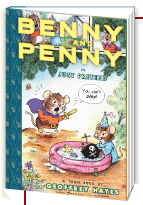
"Just Pretend"
Not such a preposterous idea. The intuitive narrative form of comics is a whole another kind of reading.
Searching words, pictures and panels for clues to events big and small in a story is a more active experience than watching video on a screen.
My “great books” education came from Classics Illustrated comics, which I loved. Did they ruin my appetite for dinner?
Heck no, I read plenty of real classics later. My readings of the actual Men Against the Sea, The Dark Frigate, King Solomon’s Mines, Frankenstein, David Copperfield, Dr. Jekyll and Mr. Hyde and so many more were only enhanced by my first reading their comic book counterparts.
(In many cases the comics reading was a richer experience than plowing through the actual classic texts. Maybe that says more about me than any literary works. However that’s a story for another post.)
Thank you, Albert Kanter for the great contribution you made to kid culture with the Classic Illustrated series that ran for 30 years beginning in 1941.
On that note, Toon Books, produced by Raw Junior, LLC , endeavors to make comics readers of toddlers and tots.
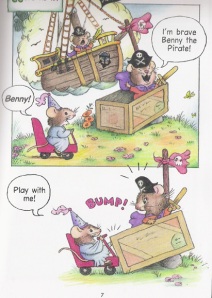
"Just Pretend"
And who better to tease little ones with artful pictures and graphics into an early habit of reading than, well, another comic book publisher.
And, in this case, someone who is also a New Yorker magazine art director.
Françoise Mouly is a veteran of more than 800 New Yorker covers, a mom, and the co-founder and co-editor, with her husband cartoonist Art Spiegelman, of the avant garde comics anthology Raw Graphics. That’s where Spiegelman’s family account of the Holocaust, Maus, A Survivor’s Tale, that later won the Pulitzer Prize, first appeared. It was the first comic book to call itself a graphic novel .
Mouly also designed and edited books for Pantheon and Penguin in the late 1980’s and early 1990s. She was helping her first grade son with his reading. she discovered — to her dismay — “beginner reader” texts.
She substituted for their home reading sessions her giant collection of French comic books, and that worked like a charm. It got her thinking, and in 2000 she launched the RAW Junior division to publish “literary comics” for kids of all ages.
She enlisted star writers, artists and cartoonists such as Maurice Sendak, David Sedaris, Jules Feiffer and Gahan Wilson.
In 2008 she started the Toon Books imprint. These were 6″ by 9″ hard cover “comics” that very young children could read on their own.
“Comics have always had a unique ability to draw young readers into a story through the drawings,” Mouly told an interviewer. “Visual narrative helps kids crack the code that allows literacy to flourish, teaching them how to read from left to right, from top to bottom.”
“Comics use a broad range of sophisticated devices for communication,” the Toon Books website quotes Barbara Tversky, professor of Psychology at Stanford University and a Toon Books advisor.
“They are similar to face-to-face interactions, in which meaning is derived not solely from words, but also from gestures, intonation, facial expressions and props,” Tversky says. “Comics are more than just illustrated books, but rather make use of a multi-modal language that blends words, pictures, facial expressions, panel-to-panel progression, color, sound effects and more to engage readers in a compelling narrative.”

"The Big No-No"
I like the Benny and Penny series by author illustrator Geoffrey Hayes, about sibling mice — a big brother and his little sister and do they ever ring true! In the latest title, The Big No-No, released this Spring, Benny and Penny confront the “new kid” next door.
In Just Pretend, Penny threatens to disrupt Benny’s make believe pirate game (because she needs a hug). But they somehow manage to play together. When Penny momentarily disappears in a game of hide and seek, Benny decides that pretending is better with his sister around than not.
Hayes has written and illustrated about 40 books, including early readers and a Margaret Wise Brown title, When the Wind Blew.
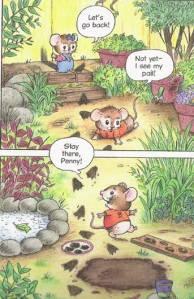
"The Big No-No!"
The Big No-No and Just Pretend are gently rendered in colored pencil and beautifully orchestrated and paced. The pages are a joy to experience. The little dialogue balloons are so natural and unobtrusive. The books give you the feeling that you’re eavesdropping on the real conversations of real children.
You can read a fascinating interview with Hayes on the Seven Impossible Things Before Breakfast blog.
I haven’t yet seen Stinky about a polka-dotted swamp monster whose turf gets invaded by a little boy. It’s creator is a 25 year old rising comics star Eleanor Davis, a recent graduate of the Savannah College of Art and Design. The American Library Association named Stinky its Theodor Seuss Geisel Honor Book for this year.

"Stinky"
* * * * *
Mark Mitchell hosts “How To Be A Children’s Book Illustrator.” To sample some free lessons from his online course on children’s book illustration, go here.







By:
Mark G. Mitchell,
on 6/3/2009
Blog:
How To Be A Children's Book Illustrator
(
Login to Add to MyJacketFlap)
JacketFlap tags:
News,
American Library Association,
David Sedaris,
Jules Feiffer,
Pictures worth a thousand words,
Art Spiegelman,
Eleanor Davis,
Françoise Mouly,
Geoffrey Hayes,
Benny and Penny,
"Maus",
"Seven IMpossible Things Before Breakfast,
"Stinky",
Classics Illustrated Comic Books. Raw,
Gahan Wilson,
Maurice Sendark,
Savannah College of Art and Design,
Theodor Seuss Geisel Honor Book,
Toon Books,
Add a tag
“Graphic novels” for little bitty kids?
Comics for children age four and up?
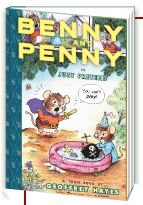
"Just Pretend" by Geoffrey Hayes
Not such a preposterous idea. The intuitive narrative form of comics is a whole another kind of reading: Searching panels and pictures along with words for clues to events big and small in the story is an immersion narrative experience. It’s more active than watching video on a screen.
My “great books” education came from Classics Illustrated comics, which I loved. Did they ruin my appetite for dinner?
Heck no, I read plenty of real classics later. My readings of the actual Men Against the Sea, The Dark Frigate, King Solomon’s Mines, Frankenstein, David Copperfield, Dr. Jekyll and Mr. Hyde and so many more were only enhanced by my first reading their comic book counterparts.
(In many cases the comics reading was a richer experience than plowing through the actual classic texts. Maybe that says more about me than any literary works. However that’s a story for another post.)
Thank you, Albert Kanter for the great contribution you made to kid culture with the Classic Illustrated series that ran for 30 years beginning in 1941.
On that note, Toon Books, produced by Raw Junior, LLC , endeavors to make comics readers of toddlers and tots.
And who better to tease little ones with artful pictures and graphics into an early habit of reading than, well, another comic book publisher.
Or more precisely a comics publisher/New Yorker magazine art director.
Françoise Mouly is a veteran of more than 800 New Yorker covers, a mom, and the co-founder and co-editor, with her husband cartoonist Art Spiegelman, of the avant garde comics anthology Raw Graphics. That’s where Spiegelman’s family account of the Holocaust, Maus, A Survivor’s Tale, that later won the Pulitzer Prize, first appeared. It was the first comic book to call itself a graphic novel .
Mouly also designed and edited books for Pantheon and Penguin in the late 1980’s and early 1990s. She was helping her first grade son with his reading. she discovered — to her dismay — “beginner reader” texts.
She substituted for their home reading sessions her giant collection of French comic books, and that worked like a charm. It got her thinking, and in 2000 she launched the RAW Junior division to publish “literary comics” for kids of all ages.
She enlisted star writers, artists and cartoonists such as Maurice Sendak, David Sedaris, Jules Feiffer and Gahan Wilson.
In 2008 she started the Toon Books imprint. These were 6″ by 9″ hard cover “comics” that very young children could read on their own.
“Comics have always had a unique ability to draw young readers into a story through the drawings,” Mouly told an interviewer. “Visual narrative helps kids crack the code that allows literacy to flourish, teaching them how to read from left to right, from top to bottom.”
“Comics use a broad range of sophisticated devices for communication,” the Toon Books website quotes Barbara Tversky, professor of Psychology at Stanford University and a Toon Books advisor.
“They are similar to face-to-face interactions, in which meaning is derived not solely from words, but also from gestures, intonation, facial expressions and props,” Tversky says. “Comics are more than just illustrated books, but rather make use of a multi-modal language that blends words, pictures, facial expressions, panel-to-panel progression, color, sound effects and more to engage readers in a compelling narrative.”
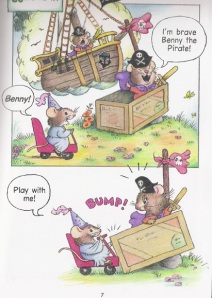
I like the Benny and Penny series by author illustrator Geoffrey Hayes, about sibling mice — a big brother and his little sister and do they ever ring true! In the latest title, The Big No-No, released this Spring, Benny and Penny confront the “new kid” next door.
In Just Pretend, Penny threatens to disrupt Benny’s make believe pirate game (because she needs a hug). But they somehow manage to play together. When Penny momentarily disappears in a game of hide and seek, Benny decides that pretending is better with his sister around than not.
Hayes has written and illustrated about 40 books, including early readers and a Margaret Wise Brown title, When the Wind Blew. The Big No-No and Just Pretend are gently rendered in colored pencil and beautifully orchestrated and paced. The pages are a joy to experience. The little dialogue balloons are so natural and unobtrusive. The books give you the feeling that you’re eavesdropping on the real conversations of real children.
You can read a fascinating interview with Hayes on the Seven Impossible Things Before Breakfast blog.
 I haven’t yet seen Stinky about a polka-dotted swamp monster whose turf gets invaded by a little boy. It’s creator is a 25 year old rising comics star Eleanor Davis, a recent graduate of the Savannah College of Art and Design. The American Library Association named Stinky its Theodor Seuss Geisel Honor Book for this year.
I haven’t yet seen Stinky about a polka-dotted swamp monster whose turf gets invaded by a little boy. It’s creator is a 25 year old rising comics star Eleanor Davis, a recent graduate of the Savannah College of Art and Design. The American Library Association named Stinky its Theodor Seuss Geisel Honor Book for this year.


The big No-No! by Geoffrey Hayes
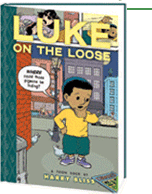
"Luke on the Loose" by Harry Bliss
* * * * *
Mark Mitchell hosts “How To Be A Children’s Book Illustrator.” To sample some free lessons from his online course on children’s book illustration, go here.







By: Michelle,
on 4/3/2009
Blog:
OUPblog
(
Login to Add to MyJacketFlap)
JacketFlap tags:
Blogs,
David Sedaris,
A-Featured,
Book Tour,
New Yorker,
"Go Carolina",
Paramount Theater,
Talking Heads,
When You Are Engulfed in Flames,
Add a tag
Below is another reflection on the life of a publicist from Michelle Rafferty. Rafferty has been a Publicity Assistant at Oxford University Press since September 2008. Prior to Oxford she interned at Norton Publishing for a summer and taught 9th & 10th grade Literature. She is chronicling her adventures in publishing every Friday so be sure to visit again next week.
When it comes to authors and actors I love, I can admit that what often begins as a routine Google search, sometimes develops into minor celebrity obsession. When I get the chance to meet some of these people, my perfectly planned speeches about how they changed my life go awry, and I usually just stand, silently gawking as they sign my book or theater bill, and then run away. I don’t forget what I plan on saying, rather I am terrified that anything I do or say will make me look like I an idiot; in this case I decide that the great American adage “the greatest risks are those not taken” simply doesn’t apply. If I make a fool out of myself, I’ll never live it down, reminded of it every time I see their face on a magazine cover. What if my favorite author hated me? I never could read their work again.
So when my friend invited me to a David Sedaris reading I became excited, not only because he is one of my favorite writers, but also because I thought I had a real shot of not looking like an idiot in front of him. I happened to read a piece of his in The New Yorker that week, in which he describes how (unlike a lot of authors) he loves his book tours, and puts in great effort to come up with a special question and gift for each person who approaches his signing table. This was good news. I didn’t have to start the conversation or come up with some meaningful anecdote. As far as I was concerned, when I marched up to that table, the ball was in his court.
In our seats at the Paramount Center for the Arts, in Peekskill, New York, my friend turned to me and said, “I bet he thinks we are all kind of dumb, spending $60 on tickets to hear him read stuff that we could just read ourselves.” I never thought about it this way, and my celebrity anxiety began to resurface. What if he was right—what if David Sedaris does see his blindly adoring fans as idiots? I could see his next essay saying something along the lines of: “How do you make money in these economic times? Simply open up a book, read and call it a tour, charging $60-$80 a pop.” As the evening progressed, I found that my friend was wrong on two fronts: 1) David Sedaris read all new material, so we couldn’t have read the stuff on our own 2) He didn’t think we (the fans) were dumb at all.
His new material was fresh and innovative, and in David Sedaris style: funny, empathetic, and perceptive when recalling his symbiotic relationships with loved ones and perfect strangers alike. After he read his first two essays and his diary entries, covering significant topics like the inauguration, gay marriage, and making nachos out of the consecrated Body of Christ, he played a clip from his favorite audio book Talking Heads (which he recommended “before anything I’ve written”) and closed with an open Q&A. The questions weren’t especially cerebral, sometimes not questions at all, for example, “Will you sing?”, “When did you start writing in your diary?”, and “Your dad seems like a great guy!” He responded kindly and at length, clearly having a great time. He even shared his diary entries over the past few days (which he keeps in a little notepad in his front pocket).
I also learned that our opinions mattered. One audience member asked why he was circling words with his pen when he read, and he explained that he was editing, making syntactical adjustments and gauging our reactions. He said, “When the audience coughs, it’s like they are throwing skulls at you,” and noted that after several readings his second story became much shorter.
At the end of the evening I waited in line with When You are Engulfed in Flames clutched in my hands, while people around me filled out their “Write your name as you would like it to appear” cards. Because I was keeping my copy for myself, I simply wrote “Michelle.” While others wrote careful messages for their loved ones, my anxiety soared once more as I realized David Sedaris would surely hate me for my pure selfishness. Anxiety still growing, I chatted with my friend, trying to hear what the author was saying to his fans. I noticed that he had a special power over couples; when they left his table it seemed like they were falling in love all over again, embracing, holding hands, and looking into one another’s eyes with wide grins. I even saw one guy dip his girlfriend into the proverbial Hollywood kiss.
When we stepped up to David Sedaris’ table, we found ourselves in the presence of a warm, smiling man with a rather remarkable tan. Somehow I found myself able to answer his questions (Where are you from? What do you do?) with coherent sentences. He offered me a present from his bag (I chose a piece of bubble gum, which has since been chewed and saved). He told us a little anecdote about a mentally unstable fan, which had my friend and I cracking up. At this moment I felt so relaxed that I leaned over, looked in his eyes and asked something I had been wondering since I read his last New Yorker piece: “Did you really give out condoms to fans?” “Oh yes!” he responded, “Last night I had a bus load of 8th graders come, and they completely wiped me out of all my soaps, shampoos, and condoms.” (To clarify, these were shampoos and soaps that he picked up in his hotels during his tour.) We broke down into laughter once more, thanked him, and kindly stepped aside to let someone else enjoy the aura of David Sedaris.
As my friend and I walked down to the Peekskill train station, it smelled like rain and the streetlights seemed to twinkle. My friend knew just what to say: “He loved you!” And you know what, I think he did. But I’m not special. I think David Sedaris genuinely loves every one of his fans (even the mentally unstable ones). Sure, we make great fodder for his stories, but I also think he holds a discernible reverence for us. We indulge in his stories and his life, and he wants to learn as much about ours, which he does in as little time as he can.

Of course we’re not the only folks writing about books and bookselling. Here are a few other tidbits for you.
Have a great weekend!
When You Are Engulfed in Flames by David Sedaris
… ‘David Sedaris’s ability to transform the mortification of everyday life into wildly entertaining art,’ (The Christian Science Monitor) is elevated to wilder and more entertaining heights than ever in this remarkable new book. …
[we just can’t get enough of Mr. Sedaris’ books. His stuff sells as fast as we can find it]
Top 10 Best Selling Books of 1952
You will find these titles easily in any good used book store, garage sales, flea markets, auctions, and internet book shops. This list of the top 10 bestsellers for 1952 was compiled by Publishers Weekly magazine. …
Secrets of a Jedi Bookseller
It’s one of my favorite discussions. I love to sell books. Some might even say I have a mutant power of sorts; this uncanny ability to match a person to the perfect book, which they didn’t even know they wanted. …
Can Somebody Make Money Selling E-Books Online?
Naturally the big challenge with selling e-books is to attract traffic in high enough volumes to successfully get a steady stream of enough prospects to be able to register sales regularly. One of the ways of doing this is through …
Your books ain’t gonna sell themselves!
One of my favorite methods for marketing and selling books is with live events. This used to be my primary method before I got immersed in the power of Internet Marketing. Channel: Books Tags: selling books authors writers marketing …
Effective Strategies For Selling Books Online
The first thing that you will need to do prior to selling books online is decide which genre you would like to specialize in. Many online entrepreneurs have found that by selling books that are informative, and nonfiction in basis, …
We will be sending out these link lists a little more often, perhaps at least once a week. If you have a blog related to books and want us to include it here please drop me a line. Hope you enjoy these ones.

Sent by the long-suffering Val, this new article from Scientific American reveals the truth we in the blogosphere have known all along--blogging is good for you. It boosts dopamine, helps people make connections with other like-minded people, and yes, even fosters a sense of placebo catharsis that someone else is listening to my troubles.
If you're feeling blue, then it's time to blog. Would THAT be cool? Your doctor writes out a prescription: 3 tablets, 2 walks in the sunshine and 1 blog post and call me in the morning.
***
DID anyone else hear David Sedaris on Fresh Air last night? That guy cracks me up. Here's on a book tour for his new book, When You Are Engulfed in Flames and was talking about Hugh, his long-suffering but always heroic boyfriend who can do anything. And random association time. Sedaris's being on a book tour reminds me of Patricia Martin's inspiration for Ren Gen--David Sedaris reading to a sell out crowd.
All of this is probably, as my friend and colleague Kate says, "fascinating, but irrelevant..."
Happy Tuesday.

Here's an illustration I did of one of my favorite authors:
David Sedaris(I went to see him speak recently, he's even funnier in person!)

This image is from a series of personal work I'm doing based on David Sedaris' short stories. This one is based on the story "Chicken In the Henhouse" found in his book
"Dress Your Family in Corduroy and Denim"More to come!
~Alan



 Guest post written by
Guest post written by 








 Last night,
Last night, 









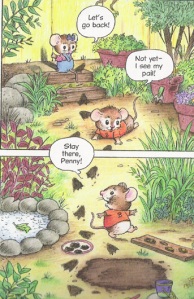









Ha! Great illustration. I loved that story. :)
Thank you Mike. It's a great story, so honest. Children can be so evil and selfish.
this is great, the cigarette is a nice touch